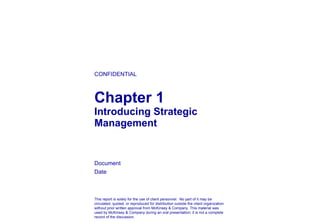
Unit 1
- 1. Chapter 1 Introducing Strategic Management
- 2. OBJECTIVES 1 2 3 4 5 Understand why we study strategic management Recognize the difference between a fundamental and a dynamic competitive advantage Describe the determinants of competitive advantage Understand the relationship between strategy formulation and implementation Understand what a strategy is and identify the difference between business-level and corporate-level strategy
- 3. A TALE OF TWO STORES 1891 1970 1990 2005 1924 Sears launches catalog business Moves into on-premise retailing/General Robert Wood takes over 1960 Experts believe Sears way was the only way to compete “The paragon of retailers” 2000 1980 Acquired by KMart 1970 Sam Walton opens first Wal-Mart with focus on low-prices 30 stores located in “one-horse towns which everybody else was ignoring”; Sam Walton 1962 2000 1980 Invests $500 million in inventory management technology Takes control of production and distribution Rapid growth, driven by end-based locations and company-controlled factories Expands into banking, investments, real estate services, and insurance Financial trouble; sells off all non-retail businesses Dizzying growth Perfects model; grows; expands into new markets (international) and store concepts (Sam’s clubs) A Firm’s per-formance is directly related to the quality of its strategy and its compe-tency in im-plementing it
- 4. TWO RETAILERS AT A GLANCE Sears Wal-Mar t Year founded 1891 1962 Stores 1980 Stores 2004 864 2026 600 5289 Revenues 1980 Revenues 2004 $25,194 million $36,100 million $1,643 million $285,222 million Net profits 1980 Net profits 2004 606M (2.4% return on sales) 507M (-1.4% return on sales) $55 M(3.3% return on sales) $10,267 M (3.6% return on sales) Market capitalization 1980 Market capitalization 2004 USD 4.8 billion USD 12.2 billion USD 1 billion USD 200.2 billion
- 5. A TALE OF TWO RETAILERS – PERFORMANCE MEASURES USD millions
- 7. STRATEGY General Lower officer (e.g., supply logistics infantry, heavy armored vehicles) Strategos: “the general’s view” Holistic “big picture” Tactical details
- 10. STRATEGY AND IMPLEMENTATION ITERATE WAL-MART EXAMPLE Strategy: The process of deciding what to do Implementation: The process of performing all the activities necessary to do what has been planned Compete as discount retailer in rural markets Leverage inventory and sourcing systems to be low-cost leader Invest heavily in organizational structure, systems, and processes
- 11. UNPLANNED ACTIONS CAN DRIVE STRATEGY Intel’s original focus (1970s & 1980s) Design and manufacture of Dynamic, Random-Access Memory Chips (DRAM) Unplanned experimental venture to make microprocessors for Busicom, a Japanese calculator maker Focus on micro-processor segment By 1984, 95% of Intel revenue came from the microprocessor segment
- 13. PROFITABILITY AND MARKET VALUATION OF US AIRLINE INDUSTRY Profitability Market valuation
- 15. GOALS OF STRATEGY IMPLEMENTATION To make sure strategy formulation is comprehensive and well informed 1 To translate good ideas into actions that can be executed (and sometimes to use execution to generate or identify good ideas) 2
- 16. IMPORTANCE OF EXECUTION “ The important decisions, the decisions that really matter, are strategic . . . [But] more important and more difficult is to make effective the course of action decided upon.” – Peter Drucker
- 18. IMPLEMENTATION LEVERS Description Implementation levers Structure is the manner in which responsibilities, tasks, and people are organized. It includes the organization’s authority structure, hierarchy, units, divisions, and coordinating mechanisms Organizational structure Systems are all the organizational processes and procedures used in daily operations. These include control and incentive systems, resource‑allocation procedures, information systems, budgeting, and distribution Systems and processes The people and rewards lever points to the importance of using all organization members to implement a strategy. Competitive advantage is generally tied to your human resources. Successful implementation depends on having the right people and then developing and training them in ways that support the firm’s strategy. In addition, rewards – how you pay your people – can accelerate the implementation of your strategy or undermine it People and rewards
- 19. COMPETITIVE ADVANTAGE Competitive Advantage: a Firm’s ability to create value in a way that its rivals cannot Key question: how do Firms create sustained above-average returns?
- 20. THREE PERSPECTIVES OF COMPETITIVE ADVANTAGE Dynamic Suggests that in dynamic, rapidly changing markets, a firm’s current market position is not an accurate prediction of future performance. Instead, we look at the past for clues about how the firm arrived at its current position and to future trends – both internal and external – in an effort to predict the future landscape Internal Often called the “resource view”, contends that firms are heterogeneous bundles of resources and capabilities and firms with superior resources and capabilities enjoy competitive advantage over other firms. This advantage makes it relatively easier to achieve consistently higher levels of performance External Also called the “positional view”, contends that variations in a firm’s competitive advantage and performance are primarily a function of industry attractiveness. Companies should therefore either (1) position themselves to compete in attractive industries or (2) adopt strategies that will make their current industries more attractive
- 21. SUMMARY Understand what a strategy is and identify the difference between business-level and corporate-level strategy 1 Understand the relationship between strategy formulation and implementation 2 Describe the determinants of competitive advantage 3 Recognize the difference between a fundamental and a dynamic competitive advantage 4 Understand why we study strategic management 5